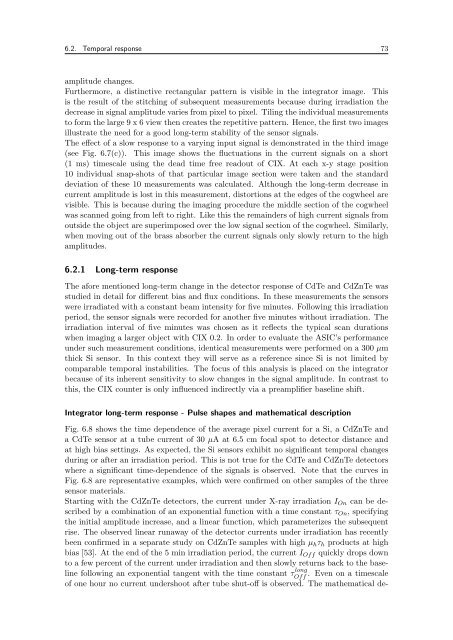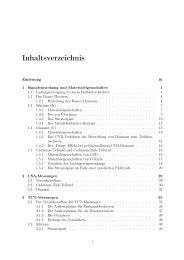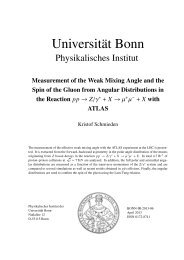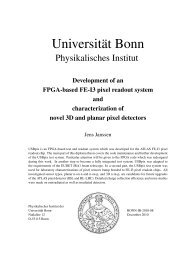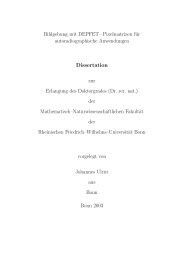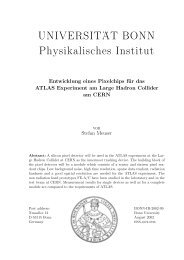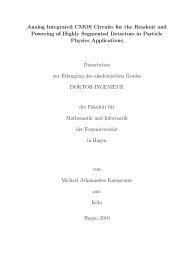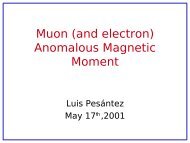UNIVERSIT . . AT BONN Physikalisches Institut - Prof. Dr. Norbert ...
UNIVERSIT . . AT BONN Physikalisches Institut - Prof. Dr. Norbert ...
UNIVERSIT . . AT BONN Physikalisches Institut - Prof. Dr. Norbert ...
You also want an ePaper? Increase the reach of your titles
YUMPU automatically turns print PDFs into web optimized ePapers that Google loves.
6.2. Temporal response 73<br />
amplitude changes.<br />
Furthermore, a distinctive rectangular pattern is visible in the integrator image. This<br />
is the result of the stitching of subsequent measurements because during irradiation the<br />
decrease in signal amplitude varies from pixel to pixel. Tiling the individual measurements<br />
to form the large 9 x 6 view then creates the repetitive pattern. Hence, the first two images<br />
illustrate the need for a good long-term stability of the sensor signals.<br />
The effect of a slow response to a varying input signal is demonstrated in the third image<br />
(see Fig. 6.7(c)). This image shows the fluctuations in the current signals on a short<br />
(1 ms) timescale using the dead time free readout of CIX. At each x-y stage position<br />
10 individual snap-shots of that particular image section were taken and the standard<br />
deviation of these 10 measurements was calculated. Although the long-term decrease in<br />
current amplitude is lost in this measurement, distortions at the edges of the cogwheel are<br />
visible. This is because during the imaging procedure the middle section of the cogwheel<br />
was scanned going from left to right. Like this the remainders of high current signals from<br />
outside the object are superimposed over the low signal section of the cogwheel. Similarly,<br />
when moving out of the brass absorber the current signals only slowly return to the high<br />
amplitudes.<br />
6.2.1 Long-term response<br />
The afore mentioned long-term change in the detector response of CdTe and CdZnTe was<br />
studied in detail for different bias and flux conditions. In these measurements the sensors<br />
were irradiated with a constant beam intensity for five minutes. Following this irradiation<br />
period, the sensor signals were recorded for another five minutes without irradiation. The<br />
irradiation interval of five minutes was chosen as it reflects the typical scan durations<br />
when imaging a larger object with CIX 0.2. In order to evaluate the ASIC’s performance<br />
under such measurement conditions, identical measurements were performed on a 300 µm<br />
thick Si sensor. In this context they will serve as a reference since Si is not limited by<br />
comparable temporal instabilities. The focus of this analysis is placed on the integrator<br />
because of its inherent sensitivity to slow changes in the signal amplitude. In contrast to<br />
this, the CIX counter is only influenced indirectly via a preamplifier baseline shift.<br />
Integrator long-term response - Pulse shapes and mathematical description<br />
Fig. 6.8 shows the time dependence of the average pixel current for a Si, a CdZnTe and<br />
a CdTe sensor at a tube current of 30 µA at 6.5 cm focal spot to detector distance and<br />
at high bias settings. As expected, the Si sensors exhibit no significant temporal changes<br />
during or after an irradiation period. This is not true for the CdTe and CdZnTe detectors<br />
where a significant time-dependence of the signals is observed. Note that the curves in<br />
Fig. 6.8 are representative examples, which were confirmed on other samples of the three<br />
sensor materials.<br />
Starting with the CdZnTe detectors, the current under X-ray irradiation IOn can be described<br />
by a combination of an exponential function with a time constant τOn, specifying<br />
the initial amplitude increase, and a linear function, which parameterizes the subsequent<br />
rise. The observed linear runaway of the detector currents under irradiation has recently<br />
been confirmed in a separate study on CdZnTe samples with high µhτh products at high<br />
bias [53]. At the end of the 5 min irradiation period, the current IOff quickly drops down<br />
to a few percent of the current under irradiation and then slowly returns back to the baseline<br />
following an exponential tangent with the time constant τ long<br />
Off . Even on a timescale<br />
of one hour no current undershoot after tube shut-off is observed. The mathematical de-


